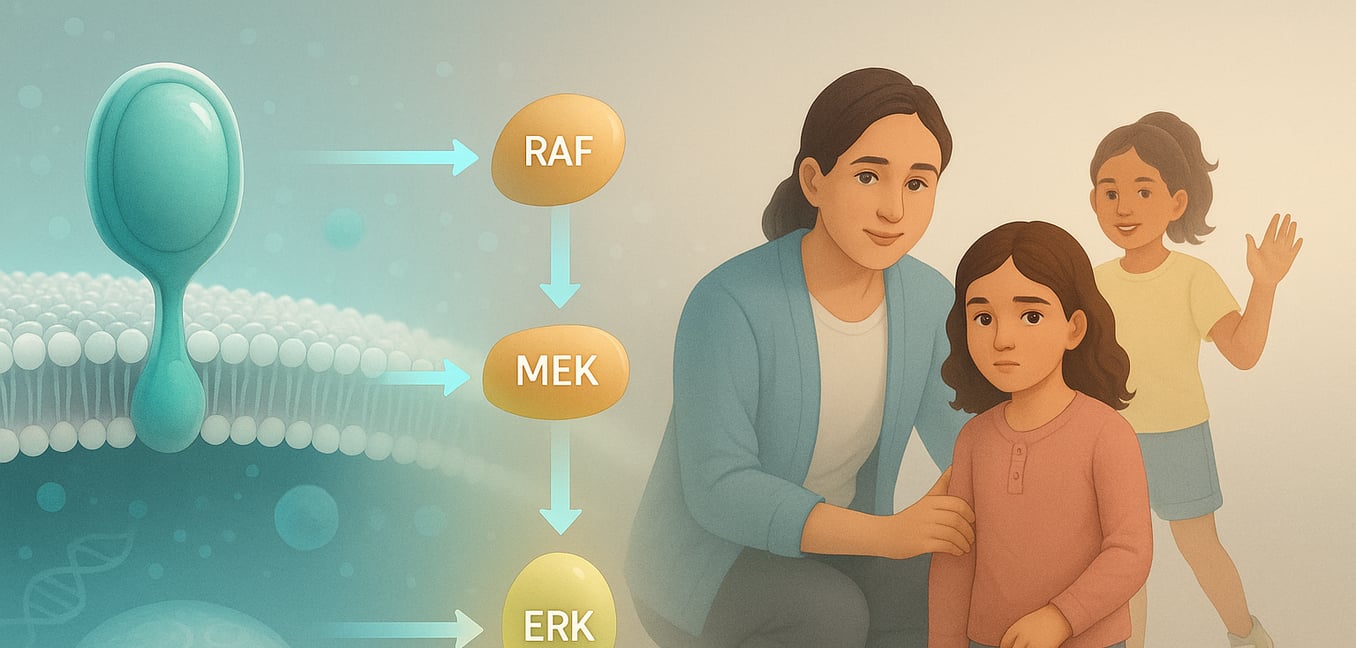Understanding Noonan Syndrome: A Brief Genetic Guide
Noonan syndrome is a genetic condition that affects development in many parts of the body11. It is caused by changes in genes that control a vital signaling system within our cells, known as the RAS-MAPK pathway8. This pathway acts like a control panel for cell growth, specialization, and survival10.
The Overactive Pathway: RAS-MAPK
Think of the RAS-MAPK pathway as a chain of command that relays instructions from a cell’s surface to its nucleus115. In Noonan syndrome, a change in one of the genes involved causes this pathway to get stuck in the "on" position95. This constant signaling disrupts normal development, leading to the wide range of features seen in the condition, from characteristic facial features and heart conditions to differences in growth11.
Genetic Causes and Inheritance
While Noonan syndrome is a single condition, it can be caused by a change in one of more than 20 different genes9. A mutation in the PTPN11 gene is the most common cause, found in about half of all individuals9. Typically, a person with Noonan syndrome has a mutation in only one of these genes8.
The condition is most often inherited in an autosomal dominant pattern9. This means a child only needs to inherit one copy of the mutated gene from one parent to have the syndrome8. In many cases, the gene change occurs for the first time in a person with no family history of the condition9.
Key Social and Emotional Challenges
The overactive RAS-MAPK pathway doesn't just influence physical growth; it also plays a key role in how the brain develops10. This can lead to specific challenges in navigating the complex world of social interaction4. These difficulties are not due to a lack of desire to connect, but stem from differences in how the brain processes social and emotional information4.
Difficulty Recognizing and Naming Emotions
A common challenge is a condition known as alexithymia, which translates to "no words for emotions." This makes it hard for individuals to identify and describe their own feelings. This difficulty can, in turn, make it harder to recognize and respond to the emotions of others4. It is not a lack of feeling, but a difficulty in processing emotions, which affects everything from reading facial expressions to developing empathy.
Reading Social Cues and Different Perspectives
Many individuals with Noonan syndrome find it difficult to intuitively understand that other people have their own unique thoughts, beliefs, and intentions9. This can lead to misinterpreting social cues, such as taking a sarcastic comment literally or not understanding why someone might see a situation differently4. As a result, they may have trouble predicting how others will react or understanding the unwritten rules that guide social exchanges4.
Building and Maintaining Friendships
The challenges with reading emotions and perspectives can impact the give-and-take of friendship46. Empathy involves not just feeling for someone, but recognizing their emotional state and responding with understanding64. When this is difficult, a friend may feel that their experiences are not being acknowledged46. Disagreements are also harder to resolve when a person cannot easily detect that they have caused offense, making it difficult to apologize and repair the relationship9.
The Foundations: Communication and Brain Differences
What do these social and communication challenges look like inside the brain?4 Neuroimaging studies are beginning to show how differences in the RAS-MAPK pathway affect brain structure and function114. These findings provide a biological basis for the unique cognitive and communication profile seen in Noonan syndrome11.
A Unique Profile of Cognitive Skills
Intellectual abilities can vary widely in Noonan syndrome, from impaired to high average11. However, as a group, individuals often show a pattern of general weaknesses rather than a single major deficit9. Assessments often show lower average scores in areas like fluid reasoning, working memory, and visual-spatial skills9. This broad impact on foundational cognitive skills helps explain why many daily tasks that require integrating different abilities can be more demanding6.
How the Brain’s Wiring is Different
Think of the brain’s "white matter" as its internal highway system, made of nerve fibers that connect different regions and allow them to communicate11. In individuals with Noonan syndrome, this highway system can be organized differently114. This may slow down communication between brain areas, making it harder to process information rapidly—a skill essential for fluid conversation and understanding social situations11.
Atypical Communication Between Brain Networks
Beyond the physical wiring, the way different brain regions "talk" to each other is also affected11. Brain scans show unusual patterns of "cross-talk" between networks that do not normally work so closely together11. For example, the network involved in movement may have excessive chatter with the language network11. This inefficient communication could interfere with the precision needed for fluent speech and make it harder to generate the right response to a social cue in real time11.
The Overlap with Autism and ADHD Traits
The social and communication challenges in Noonan syndrome often resemble traits seen in Autism Spectrum Disorder (ASD)9. This overlap is thought to stem from shared biological roots, as the RAS-MAPK pathway has also been linked to many genes associated with ASD10.
Shared Traits with Autism
While the social difficulties can look similar to those in non-syndromic ASD, the autism-like profile in Noonan syndrome is distinct9. The severity of social challenges can be comparable, but there may be subtle differences, such as a lower frequency of restricted and repetitive behaviors104. This suggests the ASD-like features are an integral part of the syndrome’s unique neurodevelopmental signature, not a separate condition10.
The Added Challenge of ADHD
A key feature of the neurodevelopmental profile in Noonan syndrome is the very high rate of co-occurring Attention-Deficit/Hyperactivity Disorder (ADHD)10. In individuals with Noonan syndrome who also meet criteria for ASD, nearly 70% have significant symptoms of inattention and hyperactivity104. This dual challenge adds another layer of complexity, as difficulties with impulse control and focus can worsen the inherent social communication struggles9.
A Different Path to Diagnosis
The journey to an ASD diagnosis can look different for a child with Noonan syndrome9. They often experience more widespread developmental delays, including in motor and language skills74. Parents may notice these general delays early on but may not recognize the behaviors as specific to autism until later104. This highlights that the ASD-like traits are a distinct feature of the syndrome, not just a byproduct of being globally delayed104.










